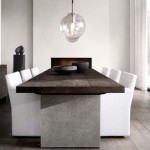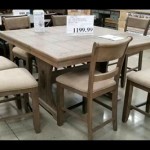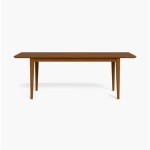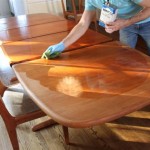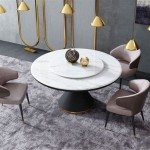Dining Tables For 12 People: A Comprehensive Guide
Selecting a dining table for 12 people is a significant decision, demanding careful consideration of various factors. These tables often serve as the focal point of large dining rooms or open-plan living spaces, hosting family gatherings, holiday feasts, and formal dinner parties. Choosing the right table involves understanding the dimensions, materials, styles, and practical considerations that contribute to its functionality and aesthetic appeal.
The scale of a 12-person dining table makes it a noteworthy investment. The selected table must not only accommodate a large number of guests comfortably but also harmonize with the existing décor and functionality of the surrounding space. Therefore, a thorough evaluation of different table options is crucial before making a purchase.
One of the initial steps is to determine the available space. Measuring the dining area accurately is essential to ensure the table fits without overwhelming the room. Adequate space around the table is also necessary for comfortable movement and to prevent a cramped feeling. This includes space for chairs to be pulled out and for people to walk around the table without difficulty. A common guideline recommends at least 3 feet (36 inches) of space between the edge of the table and any walls or furniture.
The selection of the appropriate shape is also vital. Rectangular tables are the most common choice for seating 12 people, as they maximize seating capacity and provide a classic, formal aesthetic. However, oval tables can also work well, offering a softer, more contemporary look. Round tables are generally not ideal for seating such a large group, as they require a very large diameter, which can be impractical for most homes. Square tables of this size are rarely manufactured as they pose challenges for conversation across the large distance.
Key Point 1: Understanding Dimensions and Space Requirements
The dimensions of a 12-person dining table are critical for ensuring comfortable seating and adequate space for place settings. While exact measurements may vary based on design and style, a general guideline is a rectangular table approximately 96 to 120 inches in length and 42 to 48 inches in width. This provides sufficient room for diners to sit comfortably and have enough space for their plates, cutlery, and glasses.
Beyond the table's dimensions, it is important to consider the leg placement and the overall footprint of the table base. Some table designs feature legs positioned close to the corners, which can limit legroom for diners seated at the ends of the table. Other designs incorporate pedestal bases or trestle legs that may offer more legroom but could potentially interfere with chair placement. Carefully reviewing the table's base design is crucial to avoid any discomfort for guests.
Furthermore, it is necessary to account for the space required for chairs around the table. Each diner requires approximately 24 to 30 inches of width to sit comfortably. Consequently, ensuring that the table length accommodates this requirement for 12 people is essential. The depth of the chairs should also be considered to ensure adequate space for movement around the table.
The overall layout of the dining room should also be considered. Furniture such as sideboards, buffets, or display cabinets can further impact the available space. Carefully planning the placement of these items in relation to the dining table is crucial to maintaining a comfortable and functional dining environment.
Considering extension tables may be a viable option for those who do not regularly need to seat 12 people. Extension tables allow the user to shorten the length for smaller gatherings and then extend it to accommodate a larger group when needed. This provides flexibility and optimizes the use of space in the dining area.
Key Point 2: Material Choices and Aesthetic Considerations
The material of a dining table significantly impacts its durability, aesthetics, and overall cost. Common materials include wood, glass, metal, and various engineered materials. The choice of material should align with the desired style, budget, and level of maintenance.
Wood tables are a classic choice, offering warmth, beauty, and durability. Hardwoods such as oak, maple, and walnut are particularly popular due to their strength and resistance to wear and tear. Softwoods like pine are more affordable but may be more susceptible to scratches and dents. The finish of the wood also affects its appearance and durability. A clear finish showcases the natural grain of the wood, while a painted finish can add color and style to the dining room.
Glass dining tables offer a contemporary and elegant look. They can create a sense of spaciousness, particularly in smaller dining rooms. Tempered glass is a strong and safe option, resistant to shattering. However, glass tables require regular cleaning to maintain their clarity and can show fingerprints and smudges easily. The base of a glass table is typically made of metal or wood and can contribute to the overall style of the table.
Metal dining tables offer a modern and industrial aesthetic. They are typically very durable and resistant to scratches and dents. Metal tables can be made of steel, aluminum, or wrought iron, each offering a unique look and feel. The finish of the metal can be polished, brushed, or powder-coated, allowing for various design options.
Engineered materials such as laminate, veneer, and MDF (Medium Density Fiberboard) offer affordable and versatile options. Laminate tables are durable and easy to clean, making them a practical choice for families with children. Veneer tables feature a thin layer of real wood adhered to a substrate, offering the look of solid wood at a lower cost. MDF tables are strong and stable, providing a good surface for painting or veneering.
The style of the dining table should complement the existing décor of the dining room. Traditional dining tables often feature ornate details, such as carved legs and decorative trim. Modern dining tables typically have clean lines and minimalist designs. Contemporary dining tables often incorporate a mix of materials and unexpected shapes. The choice of style should reflect personal preferences and the overall aesthetic of the home.
Key Point 3: Practical Considerations and Maintenance
Beyond aesthetics, several practical considerations should be taken into account when selecting a 12-person dining table. These include the table's stability, ease of cleaning, and overall maintenance requirements. A large dining table must be sturdy and stable to prevent wobbling or tipping, especially when fully loaded with food and drinks.
The ease of cleaning is a crucial factor, particularly for households with children or frequent entertaining. Tables with smooth, non-porous surfaces are generally easier to clean than those with textured or porous surfaces. Spills should be cleaned promptly to prevent staining or damage to the table's finish. The finish of the table should also be resistant to water rings and heat damage.
Maintenance requirements vary depending on the material of the table. Wood tables may require periodic polishing or oiling to maintain their luster and protect the wood from drying out. Glass tables require regular cleaning to remove fingerprints and smudges. Metal tables may need occasional cleaning to prevent rust or corrosion. Engineered materials are generally low-maintenance, requiring only regular cleaning with a damp cloth.
The chairs selected to accompany the dining table should also be considered. The chairs should be comfortable, sturdy, and appropriately sized for the table. The height of the chairs should allow for comfortable legroom and easy access to the table. The style of the chairs should complement the style of the table and the overall décor of the dining room.
Storage considerations should also be taken into account. If the dining table is an extension table, it is important to have a convenient place to store the extra leaves when they are not in use. This could be a closet, a storage room, or even under a bed. Choosing a table with built-in storage can be a practical solution.
Finally, it is important to consider the weight of the dining table. A large dining table can be quite heavy, making it difficult to move or reposition. If mobility is a concern, consider a table with lighter materials or one that can be easily disassembled. The delivery and installation of the table should also be considered, particularly for large and heavy tables. Ensure that the delivery team is equipped to handle the table safely and efficiently.

12 Person Dining Table Set 2025

12 Person Dining Table Ten Foot Trestle Conference Last Supper Twelve Etsy

12 Person Dining Set Top

Large Dining Table Seats 10 12 14 16 People Huge Big Tables

Expert Advice How To Design A Perfectly Scaled Dining Room The Kuotes Blog

Large Dining Table Seats 10 12 14 16 People Huge Big Tables

Huge 12 Seater Dining Table Tables Adelaide

12 Luxury Dining Tables Ideas That Even Pros Will Chase

9 Best Extendable Dining Tables To Increase Seating In 2025

8 Dinning Room Ideas Dining Table Large

